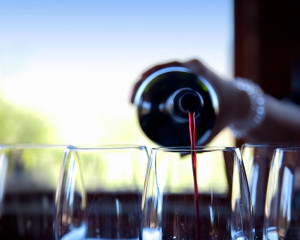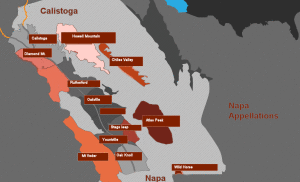
Why and How to Store Wine
In general, a wine will develop complexity and a more aromatic bouquet if it is allowed to age slowly, properly stored. The lower the temperature, the more slowly a wine develops. On average, the rate of chemical reactions in wine doubles with each 18 °F (8 °C) temperature increase.
Storage of wine is mostly all about temperature, light and humidity followed up with vibration and bottle orientation.
Wine is susceptible to changes in temperature.
Wine stored at fluctuating room temperature has a short life expectancy. The further you move from that, the longer it can be stored.
High or low temperature, or temperature swings can cause adverse chemical reactions in the wine that may lead to a variety of problems. The more dramamatic the extreme of any of those three, the worse it is. Most experts recommend that wine be kept at constant temperatures between 50 and 59 °F (10 and 15 °C), with no variation of more than 3 °F over time. If the wine is exposed to too high a temperature (in excess of 77 °F (25 °C)) for long periods of time, it will likely become “cooked” and develop off-flavors that taste stewed. The exact length of time that a wine is at risk of exposure to high temperatures will vary depending on the wine, with some wines being able to sustain exposure to high temperatures more easily than others. If the wine is exposed to temperatures that are too cold, the wine can freeze and expand, causing the cork to be pushed out; this will allow more oxygen to be exposed to the wine.
Wine should be stored away from light, especially away from direct sunlight and fluorescent fixtures. UV rays can cause wine to be ‘light struck”, resulting in the wine having an unpleasant smell. That is why red wine bottles are dark. When and if the bottle is exposed to light, from incandescent or sodium vapor lamps is best.
Some degree of humidity is required in order to keep wines with corks from drying out. Should the cork begin to dry out, it can allow oxygen to enter the bottle, possibly causing the wine to spoil or oxidize. Even when wine bottles are stored on their sides, one side of the cork is still exposed to air. Excessive humidity can also pose the risk of damaging wine labels, which may hinder identification or hurt potential resale value. Wine experts suggest that 75% humidity is ideal. Humidity is one of the primary reasons why wine experts recommend that wine should not be kept in a refrigerator due to the refrigeration process often including dehumidifying, which can quickly dry out corks.
Wine stored on its side results in the cork more likely staying moist, as it is kept in constant contact with the wine.
Vibration in wine storage is believed to contribute to accelerated aging of wine with adverse effects.
There are different types of Wine Coolers/Wine Refrigerators/Wine Cellars.
•Electric wine coolers operate similar to ordinary refrigerators, using compressor cooling system, but they ensure more stable temperature level and the ability to set cooling temperatures that are best for your wines. Some of the high-end units maintain proper humidity (50-70% relative humidity is recommended) inside the cabinet.
•Themoelectric wine refrigerators have low noise, no vibration and energy efficency. Due to the limitations of this technology, thermoelectric cooling is applied only in small wine coolers (from 1 bottle up to cc. 30 bottle storage capacity).
•Some manufactures apply hybrid cooling technology – a combination of traditional compressor-based refrigeration and thermoelectric cooling. This ensures higher efficiency, silent operation and low electricity consumption.
•Absorption Cooling – Some manufactures use this type of refrigeration method in its wine cellars. Since absorption cooling is a physicochemical proceess, it doesn’t require compressor or motor, ensuring silent, vibration-free operation.
•Dual temperature zone wine coolers have two separate compartments with individual temperature controls for storing red and white wines separately, at different temperatures within one cabinet.
•Multiple Temperature Zone Wine Storage Units – these units have independently controlled storage zones. Some wine refrigerators have 6 temperature zones.
Pouring and Tasting Wine
Prepare the wine glass for pouring. Hold each wine glass up to a light and buff away any visible dust, marks or smudges. This will allow the wine to be viewed clearly, which is an integral part of evaluating its quality. Wine glasses are best stored in an enclosed space, upside-down to prevent dust from accumulating in the glass
in an enclosed space, upside-down to prevent dust from accumulating in the glass
Remove the foil (sometimes wax) from the wine bottle’s neck, by cutting ut the foil cover about half an inch (1 cm) below the bottle’s lip. This will keep the wine from contacting the foil while you pour. Removing the foil cover can prevent unsightly drips. The foil is most easily cut using foil cutter, which allows a blade to cleanly cut around the foil.
Remove the cork. Examine and sniff the cork. Feel the cork to determine if it is intact, hard or soft, wet or dry, warm or cool. Expect older wines to show some age on the cork.
Wipe down the bottle’s opening.
Leave the glass sitting on the table when pouring. Pour the wine into the glass. Pour about 4 ounces of wine into the glass. Aim for a “fall” of about 6 to 10 inches (15 – 25 cm) – the distance from the bottle’s lip to the bottom of the wine glass’s bowl. This distance allows to wine to aerate during the pour, which improves the flavor, softening the presence of the wine’s tannins. Twist the wine bottle gently towards the end of the pour to help prevent the last bit of wine from dripping down the bottle.
Wipe the neck of the wine bottle again, to prevent any remaining wine from drying on the bottle’s lip and tainting the next pour.
Hold the glass up to the light to evaluate the wine. Tilting the glass a bit can make it easier to see the way the color changes from the center to the edges.
Look at the wine, especially around the edges. Look at the color and clarity of the wine.
Red wines tend to lose color over time while white wines become darker as they age.
Sometimes there may be a sediment in the bottom of the glass (or in the bottle). Formation of sediment is a naturally occurring process. This is not considered a fault in wine.
Swirl the wine in the glass. Some people alike to cup their hand or place a napkin over the top of glass as they swirl to trap the odor. Swirling is to spread the wine over the inside of the glass, allowing the gasses to escape from solution and reach your nose. It also opens the aromas open up, by allowing oxygen into the wine.
As you swirl, look at the wine’s viscosity (how slowly it runs back down the side of the glass) . More viscous wines are said to have “legs,”. Other than looking pretty, this has no relation to a wine’s quality.
Sniff the wine. First, hold the glass a few inches from your nose. Then let your nose go into the glass. If it is an older wine, the aromas may be more aged.
Take a taste of the wine, but do not swallow it. Expose the wine to all of your taste buds. Note the balance, texture and other tactile sensations.
Take another taste of the wine, but this time (especially if you are drinking a red wine) introduce air with it.
Note the aftertaste. How long does the finish last? You may note things in the finish that were not noted in the initial taste.
Varietals
A varietal wine is a wine made primarily from a single grape variety. Examples of grape varieties commonly used in varietal wines are Chardonnay, Cabernet Sauvignon, or Merlot. In the US, the Alcohol and Tobacco Tax and Trade Bureau regulations require a minimum variety content of 75% of the labeled grape, for most varietals, and 51% for some. Many states in the United States require specific compositions to qualify for sale under a particular varietal labels.
Napa Appellations
An appellation is a recognized wine area. The legal term Is American Viticultural Area or AVA.
The Napa Valley is itself what is referred to as an appellation. Napa Valley was California’s first recognized appellation and the second appellation recognized in the United States. Within the Napa Valley appellation, there are 16 subappellations: Atlas Peak, Calistoga, Chiles Valley District, Coombsville, Diamond Mountain District, Howell Mountain, Los Carneros, Mt. Veeder, Oak Knoll District, Oakville, Rutherford, St. Helena, Spring Mountain District, Stags Leap District, Yountville and Wild Horse Valley.
ATLAS PEAK APPELLATION
Elevation: 760–2600 feet
Climate: Cool-mountain temperatures, about 10–15º cooler
than the valley floor in the summer
Notable for: Basaltic red color soils, volcanic in origin.
Primary varieties: Cabernet Sauvignon, Chardonnay
CALISTOGA APPELLATION
Elevation: 300–1200 feet
Climate: Summer temperatures may peak above 100º and drop
to low 40sº at night
Notable for: Soils of volcanic origin, with rocky clay on the hillsides, and heavier clay-silt in the valley areas
Primary varieties: Cabernet Sauvignon, Zinfandel, Syrah, Petite Sirah
CHILES VALLEY DISTRICT APPELLATION
Elevation: 600–1200 feet
Climate: Summer temperatures reach the mid-80sº, but due to
elevation and evening fog, may drop to below 50º
Notable for: Good fertility on valley and less fertility on the hillsides. Silty-clay soils in the valley and rocky clay on the hillsides.
Primary varieties: Cabernet Sauvignon, Merlot, Cabernet Franc
COOMBSVILLE APPELLATION
Elevation: 100-500 feet (small portion over1000 feet)
Climate: Temperate climate
Notable for: Alluvial deposits and weathered volcanic rock
Primary varieties: Cabernet Sauvignon, Merlot, Syrah, Pinot Noir, Chardonnay
DIAMOND MOUNTAIN DISTRICT APPELLATION
Elevation: 400–2200 feet
Climate: Moderately warm temperatures with less fluctuation than the north
Napa Valley; summer temperatures from 50–90° (10–32°C)
Notable for: Reddish gritty soils of volcanic origin. Tannic, with mineral, and cedary taste. Usually needs aging.
Primary varieties: Cabernet Sauvignon, Cabernet Franc
HOWELL MOUNTAIN APPELLATION
Elevation: 600–2600 feet
Climate: Somewhat warmer and drier due to strong afternoon sun.
Notable for: volcanic soils on and area of low fertility. Tannic, with acidity. Usually needs aging.
Primary varieties: Cabernet Sauvignon, Merlot, Zinfandel, Viognier
LOS CARNEROS APPELLATION
Elevation: Sea level–700 feet
Climate: Cool, high temperatures rarely exceed 80º
Notable for: Shallow clay dominated soil.
Primary varieties: Merlot, Pinot Noir, Chardonnay
MOUNT VEEDER APPELLATION
Elevation: 500–2,600 feet
Climate: Cool to moderate temperatures, with most vineyards above the fog line.
Noted for: Tannic and minerally, but strong flavors. Primary varieties: Cabernet Sauvignon, Merlot, Zinfandel, Chardonnay
OAK KNOLL DISTRICT OF NAPA VALLEY APPELLATION
Elevation: Sea level–800 feet
Climate: Moderate to cool temperatures, with marine air and fog often remaining until late
morning.
Primary varieties: Cabernet Sauvignon, Merlot, Chardonnay,
Sauvignon Blanc, Riesling
OAKVILLE APPELLATION
Elevation: Sea level–500 feet
Climate: Moderately warm temperatures
Primary varieties: Cabernet Sauvignon, Merlot, Sauvignon Blanc
RUTHERFORD APPELLATION
Elevation: Sea level–600 feet
Climate: Moderately warm.
Primary varieties: Cabernet Sauvignon, Merlot, Cabernet Franc, Zinfandel
SPRING MOUNTAIN DISTRICT APPELLATION
Elevation: 600–2600 feet
Climate: Cooler temperatures prevail.
Primary varieties: Cabernet Sauvignon, Merlot, Cabernet Franc, Zinfandel, Chardonnay
ST. HELENA APPELLATION
Elevation: 100–700 feet)
Climate: Warm temperatures, with greater protection from the hills,Primary varieties: Cabernet Sauvignon, Cabernet Franc, Merlot, Syrah,
Zinfandel, Viognier
STAGS LEAP DISTRICT APPELLATION
Elevation: Sea Level to 400 feet
Climate: Moderately warm temperatures, Primary varieties: Cabernet Sauvignon, Merlot, Sangiovese, Chardonnay, Sauvignon Blanc
WILD HORSE VALLEY APPELLATION
Elevation: 600–1900 feet
Climate: Warmer area temperatures.
Primary varieties: Cabernet Sauvignon, Pinot Noir, Chardonnay
YOUNTVILLE APPELLATION
Elevation: 20–200 feet
Climate: Moderate temperatures, with cooler marine air and fog contributing to cooler
mornings.
Primary varieties: Cabernet Sauvignon and Merlot
The Way to Wine is a Road through Walt’s
Walt’s Wine Guide – Napa Valley is your best resource for Wine Tasting Guides and information.
